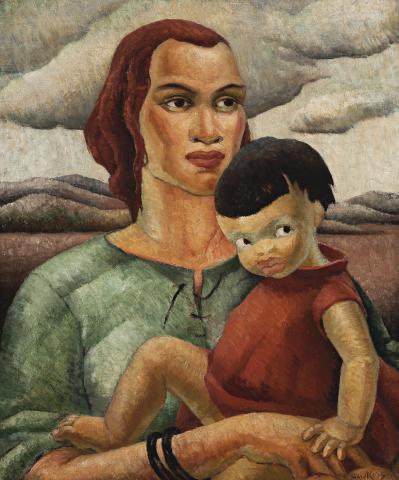GYPSY MOTHER, c.1939
SHEILA HAWKINS
oil on linen
60.0 x 49.0 cm
signed lower right: HAWKINS
Paisnel Gallery, London, acquired from the artist c.1990
Private collection, Tasmania, acquired from the above, 1990s
Goupil Gallery Salon, 33rd exhibition, New Burlington Galleries, London, July 1939, cat. 318 (as ‘Gipsy Mother’)
Sheila Hawkins was born in the remote Western Australian goldfield town of Kalgoorlie in 1905. Her father was an architect and surveyor and her mother was among the earliest pioneers of the town. She spent her early childhood there before the family with four children moved to Perth, then Melbourne during the First World War. In Melbourne she completed her schooling at Toorak College followed by a brief period at the National Gallery of Victoria Art School. Still only aged 18 she moved to Sydney and began to make a living doing pokerwork, which involved burning designs and lettering onto skins often to be used as legal documents. She completed a course in commercial art at Sydney Technical College and exhibited in mixed and solo shows in Melbourne and Sydney in 1930–31. The National Gallery of Victoria purchased a drawing, The Drift Net from her first exhibition in 1930.
In 1931, with Australia in the midst of Depression, she moved to London and took a job as a poster artist with Shell Mex Advertising, the company’s first female employee. In London she began a long career in illustrating children’s books, with her first book, Margaret Brown’s Black Tuppenny , published by Heinemann in 1932.
In 1934 she joined her New Zealand friends, the artist James Cook and his wife, Ruth to live in Catalonia on the Iberian Peninsula. They shared a primitive apartment in Gerona providing Sheila Hawkins with the opportunity to paint every day. The move to Spain was a gamble but the opportunity to just live simply and paint day by day was one too great to miss. The three of them moved into a couple of rooms above a small shop in Gerona, and Sheila and ‘Jimmy’ were free to go out and paint on a daily basis. Often cold and hungry, Hawkins nonetheless always remembered this experience as the best year of her life and its memory was to influence her output throughout the rest of her career. However, as civil unrest began to take hold, they were eventually persuaded to leave by locals who warned them of the mounting dangers which led to the outbreak of the Spanish Civil War (1936–39).
Returning to England, Sheila Hawkins continued to work on images from her life in Spain which would have included her Catalan market and gypsy subjects. One senses that although she needed to earn a living she was tempted to keep these works as a reminder of her experiences. Having enjoyed some success with her earliest illustrated book, Black Tuppenny, Frederick Warne published a second children’s book, Ena, Meena, Mina, Mo and Benjamin in 1935.
Sheila Hawkins’ marriage to Max Bowden in 1934 took her to a life in rural Northumberland and then the Cotswolds, so that by the mid 1930s she was largely absorbed by her illustrative work, which despite her always feeling it was secondary to her painting, brought her a much needed income. She returned to London and began to exhibit with the Women’s International Art Club. But it was to her Spanish sketch books that she once again turned to for inspiration for her next book, Pepito (‘A little Spanish boy’s adventures with his donkey and a little girl called Conchita’). Published by Hamish Hamilton, it was exhibited at the Times Book Exhibition that year. Two more books followed in 1938 and 1939, but during the war she found work in a civilian capacity in a public relations job at RAAF Headquarters in London.
In 1939 Sheila Hawkins exhibited the two Catalan paintings on offer at the Goupil Gallery Salon, London and another work at the Society of Women Artists. At this stage she was living in a small flat she and her husband rented on Haymarket.
We are grateful to Emma Hicks, London for her assistance with this essay
